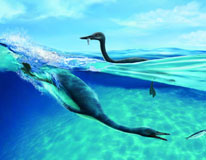- Home>
- Plan Your Visit>
- Our Exhibitions>
- Fossil Gallery>
- Marine Creatures from the Age of Dinosaurs
Marine Creatures from the Age of Dinosaurs
Think of the Canadian Prairies and images of flat fields of grain instantly come to mind. But wind the clock back 100 to 60 million years and a different picture emerges—one in which a vast inland sea, the Western Interior Seaway, submersed the region.
Anne Botman © Canadian Museum of Nature
Part of North America was covered by the Western Interior Seaway 60 to 100 million years ago.
The Western Interior Seaway bisected North America from the Arctic Ocean to the Gulf of Mexico during the Late Cretaceous Period. In Canada, almost all of Manitoba and Saskatchewan, and large parts of Alberta and the Northwest Territories, were under water at that time. At its deepest, the seaway was 300 m etres deep and as much as 1600 kilometres wide.
Strange prehistoric beasts swam this ancient sea and coexisted with dinosaurs. The Prairies were once teeming with crocodiles, sharks and other fish, birds with teeth, and all sorts of other delightfully frightening creatures.
The fossil gallery showcases many marine species from this place and period. The Imperial Oil Foundation sponsored the gallery’s marine-Cretaceous section, which profiles sea life of 85 to 65 million years ago.
Sea Monsters?
Polygone Studio © Canadian Museum of Nature
An elasmosaurid (a plesiosaur).
Visitors to the gallery will be awed by skeletons looming overhead: a plesiosaur and a mosasaur—two predatory reptiles that dominated the seaway’s waters.
Some argue that the fabled Loch Ness monster is a living example of a plesiosaur, with its long, flexible neck. Other plesiosaurs had short necks and large heads, and many reached 14 metres long. The plesiosaur on display is from the family Elasmosauridae. The specimen is a cast of the real fossilized skeleton, which was found on Vancouver Island, British Columbia.
Polygone Studio © Canadian Museum of Nature
Hesperornis gracilis.
The mosasaur was another marine giant. The largest one could swallow a variety of prey with its gaping one-metre-jaw. It dined on fish, turtles, birds, sharks and even other mosasaurs. The Komodo dragon, found today in Indonesia, is distantly related to this marine predator of long ago.
Kourisodon puntledgensis is the species of mosasaur that floats overhead in the gallery. At four metres long, it is actually considered small in comparison with its more fearsome cousins. The species is new to science: it was identified in only 2002. The specimen on display is a cast. The fossil was also found on Vancouver Island, British Columbia.
A panel mount contains the fossil skeleton of an even larger mosasaur: Platecarpus coryphaeus. This specimen was collected in Kansas in the early 1900s by George F. Sternberg, who was a member of a renowned family of palaeontologists, including his father, Charles H. Sternberg. The Platecarpus is between 7 m and 8 m in length.
Giant Turtles
Another amazing find is the largest turtle that ever lived, Archelon ischyros. This animal was about the size of a small car! Visitors to the gallery will see a cast of the largest-known and best-preserved specimen, which was discovered in South Dakota. The animal’s carapace (the bony, upper part of its shell) was not solid, but rather a series of rib-like struts covered by rubbery skin. The carapace helped keep the turtle buoyant, like that of today’s much smaller leatherback turtle.
Crocodile-like Animals
Polygone Studio © Canadian Museum of Nature
A mosasaurid.
The cast of a skull of a long-snouted crocodilian, Terminonaris robusta, is an example of a crocodile-like creature that lived in the Western Interior Seaway. The Canadian Museum of Nature’s Dr. Steve Cumbaa was part of the team that found the skull and skeleton along the Carrot River in Saskatchewan in 1991. Dr. Xiao-chun Wu (the museum’s expert on fossil crocodilians), Dr. Cumbaa and Dr. Anthony Russell (of the University of Calgary) described the species. The original, six-metre-long specimen is in the Royal Saskatchewan Museum.





